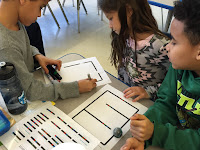The STEM lesson for 2nd grade incorporated using Ozobot Robots to teach States of Matter & Mapping Skills.
I first learned about Ozobots this past summer. I caught the Amazon Prime sale and purchased two for my kids as toys. Little did I know the impact it could have in the classroom!
2nd grade students had just completed their unit on States of Matter, and I was looking for a way to incorporate my new ozobots I won for my school, and I came across this great blog post by Kim Mattina in which she used Ozobots with middle schoolers to program the States of Matter. I modified the lesson to address curriculum objectives for 2nd grade, and then along the way, I found a way to connect it to their mapping unit too.
Curriculum Connections: States of Matter, and Mapping Skills
Science:
- Explain that matter is anything that has mass, takes up space and is composed of smaller parts.
- Compare the observable physical properties of solids, liquids, or gases.
- Identify everyday objects/substances as solid, liquid, or gas.
- Observe and describe ways water, both as a solid and liquid, is used in everyday activities at different times of the year (ex: bathe, drink, make ice cubes, build snowmen, cook, swim.)
Social Studies:
- Locate and name the key, compass rose, and title on different maps.
- Identify primary directions (ie., north, east, south, west)
- Draw and use maps of school or neighborhood with map key.
Math:
CCSS.MATH.PRACTICE.MP1 Make sense of problems and persevere in solving them.
CCSS.MATH.PRACTICE.MP5 Use appropriate tools strategically.
CCSS.MATH.PRACTICE.MP7 Look for and make use of structure.
ISTE STANDARDS:
Creativity & Innovation, Communication and Collaboration, Critical Thinking, Problem Solving, and Decision Making.
Objectives:
- Integrate Ozobot, coding, and the states of matter.
- Use coding to make connections to what they were learning in class, the states of matter, which is about the movement of molecules to form a liquid, solid and gas.
- Students will construct a map that has a map of the school that has a key, compass rose, and title
- Students will use ozobot to guide the class through their map explaining the major places along the way.
Topics: Robotics: line-following robots and color sensing
Students were placed in groups, and each person had a role.
Students learned about Ozobots and how they work.

Ozobot is a miniature robot, the smallest of its kind, and there are a lot of things it can do including:
Drive on lines & follow special color codes
You can draw a line, place the Ozobot on it, and it will follow the line. The Ozobot recognizes blue, red, black, and green marker.
There is a specific way you have to draw the lines.
The Ozobot recognizes code. Drawing color codes.
Color codes are color sequences made of two, three or four color dots in a row located directly on a path. Ozobot’s sensors are designed to read code about 150 times per second to detect red, green, blue, black and white areas and react accordingly.


Calibrate Your Ozobot
What does this mean? Ozobot’s “eyes” (the sensors) are very sensitive to the surrounding light. So much so that, if the paper changes or if you go closer to the window, it affects how Ozobot sees what’s underneath. To let Ozobot know what its surroundings are, you need to calibrate: Turn on the ozobot, place the ozobot on the black dot, and wait for it to turn green.
Mini challenge: In any of the slots, mark (blue, black, blue) and (red, black, red) and (blue, green, blue). What happens?
Place Ozobot on the line and see how the Ozobot understands the colors.
Write the correct code on the sheet.
Challenge 2: States of Matter
Each group was given chart/butcher paper, a challenge card, markers, and an ozobot.
Each group was given a copy of the story, and were to fill-in the proper ozobot codes for the correct state of matter. After completing the rectangle code blocks, then they tested their ozobot with the proper codes.
Challenge 3: Mapping Skills
Each group was given a challenge card. They had to create a map of our school, then program Mr. Oz to go to difference places based on what was on their challenge card. 













Comments
Post a Comment